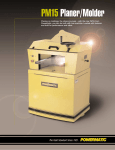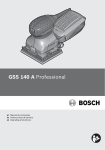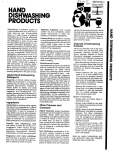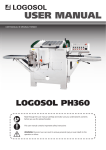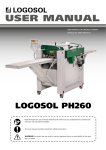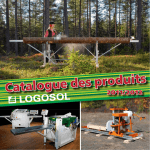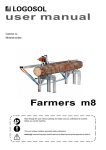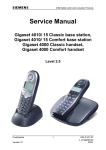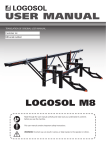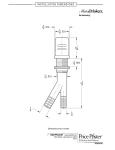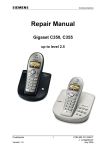Download Logosol DH410
Transcript
USER MANUAL User manual in original format. article no: 0458-395-2106 LOGOSOL DH410 Read through the user manual carefully and make sure you understand its contents before you use the planer/moulder. This user manual contains important safety instructions Warning! Incorrect use can result in serious personal injury or even death to the operator or others. Thank you for choosing a Logosol machine! Welcome! We are very pleased that you have demonstrated your confidence in us by purchasing this planer/moulder and we will do our utmost to meet your expectations. Logosol has been manufacturing sawmills since 1988, and since then we have supplied machines to satisfied customers worldwide. We are want to assist you in safely achieving the very best possible results from your planer/molder. We therefore recommend that you take the time to read this user manual from cover to cover before you begin using the machine. Remember that the planer/moulder itself is just part of the value of the product. Much of the value is also to be found in the expertise we pass on to you in the user manuals. It would be a pity if that were not utilized. We hope you get a lot of satisfaction from the use of your planer/moulder. Bengt-Olov Byström Founder and Chairman of the Board, Logosol AB LOGOSOL is engaged in continuous development of its products. We must therefore reserve the right to change the design and form of our products. Text: Bo Mårtensson Document: Logosol PH360 Manual Image: Bo Mårtensson, Lars Wahlström Last Revised: February 2011 Manual, product no. 0458-395-2106 © 2010 LOGOSOL, Härnösand Sweden 2 LOGOSOL DH410 Table of contents Safety instructions 4 Tools required 6 Machine description 6 Preparations 7 Setup 8 Chip management 8 In and outfeed table 9 Starting the sawmill 10 Control panel 10 Top cutter 11 Moulding knives in the top cutter 12 Side cutters 13 Instruction, spring plate 15 Instruction, fixed & variable feed 16 Maintenance 17 Planing/Moulding tips 18 Starter package DH410: moulding knives & examples of combinations 19 Wiring diagram 22 Overview 23 Technical data 25 EC Declaration 27 3 Safety instructions • Use approved ear protection and protective goggles. Hearing can be damaged after only a short exposure. Use approved safety goggles. Splinters and pieces of wood can be hurled our with with great force when the machine is in operation. Do not feed into the machine work pieces that are so conical that the feed roller risk losing hold. Always measure the workpiece and set suitable thickness and width before planing. There is a high risk of accident if the feed roller looses its grip of the workpiece. • Warning! Cutting tools. Never stick hands or tools above or beneath the machine table or in the chip outlets while the machine is running. Small dimensions must be planed using fixtures, e.g. a piece of wood with a customized groove that extends along the full length of the table. The same applies when the work piece is higher than it is wide. • Before starting the machine: - Get familiar with all functions and setting possibilities before using the machine. - Make sure that the cutter can rotate freely, and that no tools or loose parts are left inside the machine. - Make sure that the cover is properly closed and that the looking screw in the cover is securely tightened. - Make sure that all knobs, screws, nuts, fences, knife gibs, cutter heads knives , protective covers, in- and out-feed tables, etc. are firmly tightened/ secured. • Make sure that the chip hoses are fitted with hose clamps, and that the chip extractor is switched on. • Make sure that no other person besides that operator is within the safety distance • In this manual, the phrase ”disconnect the power” means that the cable with the CEE plug, which supplies the machine with electricity, is pulled out and placed so that no unqualified person can connect it to the machine. • Disconnect the power by pulling out the plug, and wait for the cutter head to stop before : - opening the cover to change planing/moulding knives, or to carry out any other opertion above or beneath the machine table . - replacing belts or performing any other servicing or cleaning. - moving the machine. - leaving the machine unsupervised. • Chip hose and chip extractor must be fitted securely to the machine’s chip duct, e.g. with hose clamps. For your own safety, read the entire instruction manual carefully and do not start the planer/ moulder before you have understood everything. Risk of cutting injuries. Use protective gloves when handling the knives. It is especially important that you wear gloves when loosening or tightening the lock screws for the knives and the fences (as there is a risk that you slip with the spanner). This symbol means ”WARNING!”. Be extra vigilant when this symbol appears in the manual text. This symbol is followed by a prompt. Be extra vigilant when this symbol appears in the manual text. • 4 This document is mainly a machine instruction. It does not constitute training in machine planing. If used incorrectly, the Logosol DH410 can cause serious personal injury. Always be focused and careful when using the machine. • Ensure that non-authorized persons do not use this moulder. • Never stand along the the workpiece’s extension line as kickback can occur, and bits of the workpiece can be thrown out of the planer/moulder. Also knots, splinters, or pices of the knives can be hurled out with great force. Always stand at the side of the in-feed table. • Only one work piece at a time may be fed through the machine. • Make sure that the machine is set up so that the feed roller (5*) take a firm hold of the work piece. LOGOSOL DH410 • • The machine should be equipped with in- and outfeed tables of a length of at least 1 m (3.28 ft) each. • Do not wear loose-fitting clothing or anything else that can get caught in the machine’s moving parts. If you have long hair you should put it up in a reliable way. Lift the planer/moulder using a fork-lift or pallet jack. Applications • Always work in good lighting. • Do not use the machine under the influence of alcohol or other drugs. • Keep the worksite tidy. Do not leave anything you can trip over lying on the ground. • Never put your hands or any tools on the machine table while the machine is running. • Do not climb up onto the machine. • Do not step on the machine’s power cable. The cable should be secured to the ceiling. • Place the machine so that the emergency stop is not blocked. • For maximum electrical safety, a residual current device should be used. • The machine must not be modified or added to. Only use original parts from Logosol. after servicing, the machine must be restored to its original condition. • The warning labels of the machine are there for everyone’s safety. Damaged or illegible labels must be replaced. • Dull knives increase the risk of accidents. • Risk of kickbacks. • Minimum length of the workpiece: 300 mm (11.8’’). general • Check the planer/moulder as soon as you receive it. Report any transport damage to the transport company immediately. This machine can be used for planing and moulding wood. Hard materials such as teak, MDF, etc. require hard carbide tools, see the Logosol-Toolbox catalogue. The planer/moulder is designed for indoor use, with temporary outdoor use. Environmental requirements The temperature in the premises in which the machine is stored should be above freezng, unless special measures are taken: Trapezoidal thread bars, machine table, knives, etc, must be rustprotected with oil (e.g. Super-Flo 9999-000-5115). Ventilation in the premises must be mechanical, and of a good standard. The planer/moulder must be connected to a chip extractor, which is approved according to CEstandards, see page 10. Safety distance Other than the operator, no-one should be within 3 meters (10 ft) of the planer/ moulder’s sides or 8 meters (26 ft) from the in and outfeed sides during operation. Mark a limit that prevents anyone accidentally wandering into the risk area. Tips: An extended infeed table is practical to use, and prevents anyone coming into the risk area. 3m (10 ft) Demarcation DH410 with in and outfeed table 8m (26 ft) Risk area Max 8 m (26 ft) The operator’s work area The barrier behind the infeed side 3m (10 ft) 5 tools required A list of the tools required to be able to work with the planer/moulder: Allen key 4 mm (supplied) Allen key 5 mm Allen key 6 mm Open ended wrench 10 mm (supplied) Ring wrench 10 mm Ring wrench 13 mm Open ended wrench 30 mm (supplied) (for milling spindle) Adjustable wrench size 8 or 10 (for milling spindle) Sliding caliper Measuring tape or ruler Super-Flo for the table Whetstone Silbergleit Spray kit Tips! Make a tool board with the tools you need, and position it next to the planer/moulder so that you can see it easily. Look at the tool board before you start the planer/moulder to see if any tools are missing. They could have been left in the planer/moulder! machine description The DH410 is a planer/moulder that can work two sides of a workpiece in one operation. The machine is contained ina stable and strong chassis. The machine table is made of cast iron. The workpiece is fed, lying on the machine table, through the machine by three feed rollers of which one is an out-feed roller. The rollers are driven by a chain transmission with separate motor.The work piece is controlled laterally with an adjustable fence and a pressure roller. The work is done using a top cutter, which is hung at both ends in the chassis, and a side cutter. Both cutters are driven by separate motors, via a belt transmission. 6 The cutters and feed rollers are covered by a foldable protective cover. The protective cover is supplied with a safety switch. Another safety switch sits behind the top edge of the protective cover on the infeed side. A 100 mm (4’’) hose is connected to the top cutter and side cutter for connection to a chip extractor. table surface The table is cast in the highest quality. The table surface is specially processed for the highest precision and the best anti-friction qualities. When the machine is new, it requires a running-in period until the table gets a slightly shinier surface to optimize the anti-friction qualities. During this period, we recommend that you use a lubricant or Super-Flo spray (item no. 9999-000-5115 ) on the table. LOGOSOL DH410 preparations Certain parts are not assembled on delivery for transport and packaging reasons. 1. Assemble the control panel in place with the arm where the cabling goes (22). 2. Assemble the fences. 3. Connect the planer/moulder to the chip extractor. 4. Before the planer/moulder is connected to the electrical circuit, check that all cutters can rotate freely, and that all parts are fixed. 7 setup Check your DH410 as soon as you receive it. Any transport damage must be reported to the transport company immediately. Most of the planer/moulder is protected against rust and can be stored in cold premises, but it will require extra maintenance in the form of lubrication for all the parts not protected against rust. See the Maintenance section. • Place the planer on a stable and flat ground. Preferably screw the planer down using the holes in the base, if the castor set is not used. • Ensure that there is enough space at the in and outfeed sides for the longest boards you want to machine, and that there is enough space for maintenance and timber stocks. • Connect the chip hoses and fix using the hose clamps on the planer/moulder and chip extractor. • Hang the planer’s electrical cable in the ceiling or protect it in another way. Never step on the cable. The planer/moulder should be connected via an residual current device. • Ensure that lighting is good. There should be good general lighting. Also set up a strong lamp directly over the machine. Ensure that there is no risk of glare. Space requirements The machine needs a space of at least 2 m (6 1/2 ft) width. The length required depends on the length of the workpieces you want to plane. The minimum length is 2 x the length of the workpiece plus 2 additional metres. Be aware of the risk of being crushed between the workpiece and the wall if you use the machine in a too small space. chip management The DH410 must be connected to a chip extractor with a capacity of at least 3,000 m3/h (10,000 cubic feet/hr). Logosol has a range of pipes, sleeves and hoses. Ask LOGOSOL’s advice to find a chip-handling system that suits you. Remember that you need an air vent in your chip container (e.g. a fine net or filter if you carry out chip collection indoors). Poor suction is often due to poor airflow from the chip container. If you work in heated premises, remember that the fan will quickly cool the space if you do not lead the filtered air back into the building.Consideration must be taken for fire risk and dust emissions (discharge) in connection with chip collection. 8 Position the chip extractor so that you can easily reach the switch, or let an electrician connect the chip extractor to the free button on the control panel of the planer/moulder. Chips that are left in the planer/moulder must be vacuumed up after every work session. Technical requirements chip extractor • The chip extractor must be approved according to the CE-standard. • The airflow ”without external connection” must be approx. 4000-5000 m3/hour (13,000-16,500 cubic feet/hour). Fire risk and dust emission in connection with chip management. • (The manufacturer’s standard indication of airflow.) Contact the local authorities for advice in designing a chip collection system to conform with rules in your area. • The sleeve diameters for the planer = 100 mm (4”) x 2. • The pressure loss in the planer is 26 mm of water column at 25 m/s (1 inch of water column at 82 ft/s) . LOGOSOL DH410 In- and out-feed tables Logosol supplies ready-to-use in- and out-feed tables made of steel sheet (1 table. item no. 7500-0100010). You can also build your own in- and out-feed tables. To ensure that no knife marks will be left on the ends of work pieces, it is vital that the in-feed table, the machine table, and the out-feed table are exactly level with each other. For the best results Logosol’s feed tables are to be used. 9 Starting the machine Risk of serious injury. Read the safety instructions. Check that the cutters can rotate freely. Connect the planer electrically. Watch the rotational direction. If you are standing by the feeder gear, the rotational direction of the top cutter must be counter-clockwise. The connecting plug is supplied with a phase reverser, which makes it easy to change the direction of rotation. Control panel The top red button (B) is the emergency stop and switches off the power to all functions. When the emergency stop has been activated, it must be pulled out again in order for the planer/moulder to be re-started. For the function of the other buttons, A B C see picture below. A. Start and stop B. Emergency stop (pull it out for re-starting the machine) D D E D F C. Indicator for connected power supply D, E, F Indicators for each motor G. Start, top cuttere D G D H i H. Start, side cutter I. Start, feed 10 LOGOSOL DH410 top cutter mounting and Adjusting planing knives Before you open the protective cover on the planer, ensure that the power is switched off and that the cutters are not rotating. Use protective gloves, particularly when you need to loosen screws that are tightly fastened, or when you are tightening screws (see safety instructions). Beware of the planer knives. It is extremely easy to cut yourself on these, even with the slightest touch. Adjust the planing knives so that they are at the same level and protrude 1 mm (.040”). This is done using an aluminum setting block (item no. 7500000-1020), found in the component packaging on the planer table when the planer/moulder is delivered. Loosen the chip breaker’s lock screws slightly, and pass the setting block over the knife. Adjust the knife up or down until the knife brushes against the block when it is passed over the knife. (The planing knife protrusion can also be adjusted using a magnetic adjuster for the top cutter, item no. 7500001-0050. See the instructions enclosed with the magnetic adjuster.) Disassembling the planer knives The planing knivea are disassembled by loosening the chip breaker’s (A) lock screws (B) and then unscrewing the planing knives with adjuster screws (C). Grinding the planing knife Always grind the knives in pairs, so they are the same height, min. 15 mm (.600”), otherwise vibrations could occur in the cutter. The grinding angle must be 38 degrees. You can order a grinder from Logosol for sharpening moulding and planing knives (Tormek T7 Grinder Logosol Edition item no. 7010-000-1025, Jig for planing knives item no. 7010-000-1005). After adjusting or replacing planing knives: Make sure there no tools are left inside the machine. Make sure that all screws are securely tightened. Make sure that the cutter heads can rotate freely before closing the protective cover. Always set the top cutter by moving it upwards to reduce any slack in the threads. If the top cutter needs to be lowered, lower it half a rotation too low and then raise it into the correct position. A Do you remember the safety instructions on pp.4-5? Setting block B Knife gib F Planing knife Lock screw Adjusting screw D E C 11 moulding knives in the top cutter Before you open the protective cover on the planer, ensure that the power is switched off and that the cutters are not rotating. Use protective gloves, particularly when you need to loosen screws that are tightly fastened, or when you are tightening screws (see safety instructions). Beware of the planing and moulding knives. It is extremely easy to cut yourself on these, even with the slightest touch. The top cutter head have four tooling slots. As mentioned above, the planer is delivered with two planing knives assembled in two of the tooling slots. In the other two tooling slots, moulding knives of different sizes and profiles can be assembled. • Assemble the knife gib and the moulding knife. See illustration below. • Insert the gib and the moulding knife in the wide end of the slot in the cutter head. • Warning! Unbalance in the cutter creates vibrations that can damage the planer and cause personal injury. Push the knife and gib into the groove. Measure the position using the millimetre scale on the cutter, and fix by tightening the screw tightly on the back of the gib. • Moulding knives must always be mounted in pairs, so that the cutter remains balanced. The lock screw must not be placed over the area where the tooling slots are extended. • Measure the position of the knife laterally and assemble an identical knife in exactly the same position on the cutter’s opposite side. Moulding knives can be mounted in the top cutter. Moulding knives must always be mounted in pairs – opposite each other. A certain sideways offset of the knife, can however be accepted, as long as the cutter remains balanced. Warning! If moulding knives with large protrusion are used, make sure that the cutter can rotate freely. 12 assembly LOGOSOL DH410 side cutter D A 6 8 7 C B F E Before you open the protective cover on the planer, ensure that the power is switched off and that the cutters are not rotating. Use protective gloves, particularly when you need to loosen screws that are tightly fastened, or when you are tightening screws (see safety instructions). The side cutter is fixed to the planer table. The spindle is 30 mm (1 2/10”) in diameter, which is a standard measurement. Upon delivery, the side cutter is equipped with with planing knives, which you can easily replace with moulding knives. For reasons of safety, the cutters work with conventional milling (the workpiece is fed towards the moulder’s cutting motion). Disassembling the side cutter Loosen the nut on the spindle with a 30 mm wrench (supplied) and an adjustable wrench. Unscrew the nut and remove the cutter (A) and any spacing rings under the cutter. Replacing knives Loosen the lock screw (B) with a 4 mm Allen wrench (C) (supplied) and remove the chip breaker (D). Then remove the knife (E) from the pegs (F). Insert a new knife and tighten the locking screw tightly. Ensure that you turn the knives in the right direction when you mount them in the cutter. The cutting edge must be turned towards the chip breaker. Also check that the cutter is facing the right direction on the spindle. Both of the planer/moulder’s cutters turn the same way as with conventional milling Check that the spring plate in front of the side cutter is not at risk of being bent towards the cutter by the workpiece’s unplaned edge. Pay particular attention when machining workpieces of different widths. Height setting The side cutter’s height is set by adding or removing the spacers that are supplied in the component package on delivery. Spacer height: Spacer 40 mm Spacer 20 mm Spacer 10 mm Spacer 5 mm Schim set (0,1 – 2,0 mm) art.nr. 7502-001-0038 art.nr. 7502-001-0042 art.nr. 7502-001-0044 art.nr. 7502-001-0046 art.nr. 7502-001-0230 13 To remove the planing knives from the side cutter, loosen the knives’ lock screws that are recessed into the cutters. Use a 4 mm Allen Wrench (supplied). Spacers must also be placed above the cutter so that it is fixed on the spindle. Use some of the spacers that are not used for height setting. Place the thickest spacer so that it lies highest and extends a couple of millimetres over the lowest threads on the threaded bar. Then, screw on the nut on the threaded bar and tighten it firmly. test run Always run a test piece and make subsequent adjustments. Run a straight piece through the planer at the slowest feed speed. Then measure the profile, its height and width, and subsequently adjust the cutters and the setting for the moulding knives if required. Grinding To recover the sharpness of the knives, you can grind the flat side of the knives. Thus you retain the same profile for the pair of knives. Always grind the knives in pairs, so that they have the same weight, otherwise vibrations could occur in the cutter. You can order a grinder from Logosol for sharpening planing and moulding knives (Tormek T7 Grinder Logosol Edition item no. 7010-000-1025, Jig for moulding knives item no. 7010-001-1012). If the profile of the knife is damaged, this should be re-ground by a professional knife sharpener. This is a service that is normally available locally, otherwise contact Logosol. 14 LOGOSOL DH410 instruction, spring plate The side cutter spring plate is used when you require additional lateral pressure or when the planing/ moulding causes splinters in the timber. • The spring plate is clamped between the chip guide plate, which is in front of the side cutter, and the screw plate with two threaded holes. • Set the spring plate so that it touches the board of the smallest width. • Maximum springing of the plate is 6-8 mm. • When machining boards that varies more than 6-8 mm in width, the spring plate should not be used. • Run the workpiece twice through the planer/ moulder if it is of very large dimensions. 15 instruction, fixed and variable feed fixed feed AGIP BLASIA 32 SHELL A.T.F DEXRON ESSO A.T.F DEXRON MOBIL A.T.F 220 Assembly (if the variable feed motor is not assembled in place) CASTROL DEXTRON II Assemble the feed motor package on the last feed roller. Make sure that the torque stay is in place. Lock this with the central screw on the roller. BP AUTRAN DX The fixed feed do not require maintnenance. (For variable feed, see below.) VARIAble feed Warning! Do not turn the adjustment knob when the planer/moulder is not running. Setting the feed rate Turn the wheel clockwise to increase the speed. Indicator dial for the feed rate The indicator dial is/must be mounted in the hub of the wheel. It works like an indicator that has a weight in one part, so the indicator moves. The black indicator shows a figure. The indicator dial has a relative scale. See the numbers as an indicator. The higher the number, the greater the speed. Start the planer/moulder and turn the wheel so the planer reaches minimum speed. Remove the indicator dial and turn it so the indicator is set to zero. Then press the indicator dial in with the indicator pointing upwards towards zero. Use the indicator dial so that you can return to the best speed for the profile you are planing. 16 If you have a 2-12 m/min (6-39 ft/min) gear: 0 on the indicator dial is 2 m/min (6 ft/min) 8 on the indicator dial is 12 m/min (39 ft/min) Maintenance Fluid should be visible in the fluid level glass. The level is checked when the variator is not running. Top up if no fluid is visible in the glass. Use oil for automatic gearboxes according to the table below, or use compatible oil. The variator is filled with AGIP BLASIA 32 at the factory and does not normally require an oil change during its life. The worm gear oil does not normally need changing or topping up during the life of the gear. LOGOSOL DH410 MAINTENANCE The DH410 is easy to maintain as 95% of the planer/moulder is protected against rust. The maintenance required, is mentioned below. Ensure that the power to the planer/moulder is switched off before beginning maintenance. After each work session: • Clean chips from the planer/moulder. Also remove any chips from under the planer/ moulder. • Clean any resin off the table. Use mineral spirit if necessary. Lubricate the table with paraffin oil, for example. in good condition. USING OR STORING IN COLD OR DAMP ENVIRONMENTS If the planer will be stored in a cold or damp environment over a longer period, all corrosive parts must be treated with a rust inhibitor (Super-Flo). Cover the machine. Water can condense in closed spaces. Check that the motors are dry inside by loosening the draining plugs. Check the control panel box. If necessary, drill a 4 mm draining hole in the bottom of the control panel box. Maintain at regular intervals as follows Lubricate these areas regularly: • The feed roller bearings. • Trapezoidal bars and their top and bottom bearings. • The chain for setting table height. • The chain driving the feed rollers. • The cast iron table. For lubrication: Super Flo, dry lubricant, item no 9999-000-5115. For cleaning plastic and rubber parts: Silicone spray item no 9999-000-5110. For rust protection: Universal oil, item no 9999-000-5105. For cast iron table: Silbergleit, item no 7500-001-5067. Check that all screws and bolt connections are tightened and that cables and electrical connectors are 17 planing/moulding tips 1. When you have finished moulding a profile that you know you will be moulding again, feed in a board of approx. 1 m (3 ft) long, then switch off the planer/moulder when this has been fed in. Lower the table and remove the board. Next time you are going to mould this profile, the board can be used as a template for both cutters and fences. Also note on the test board which shims and knives you used for it, as well as the position of the moulding knives in the horizontal cutter. 2. You can experiment with adjusting the pressure on the feed rollers yourself. Note the basic settings before you start, so you can always return to them. The springs must normally be tensioned more on the right-hand side, particularly if small objects are machined. The feed rollers must be balanced on the object, and not press more on either side. 3. When a small amount of timber is to be moulded, the setting becomes easier and often quicker if you first plane one side of the workpiece before you mount the moulding knives, and then turn the board so that the planed side faces the machine table while the sides are being milled. This means that you only have to set the height on the side cutter once when making tongue and groove. 18 TB90-011 5.090:- Starter package with knives and gibs for the DH410 GET STARTED AT ONCE! 10 pairs of moulding knives tha will be very useful to you! The starter package of moulding knives enables you to produce a wide range of profiles. Our experience tells us that these profiles will without doubt be very useful to you. The package includes: 10 pairs of moulding knives of HSS, and 2 pairs of knife gibs. You can do all thi s and mu ch mo re wit h the sta rte r pac kag e! Starter package with knives for the two-sided planer/moulder DH410 Incl uded in the Rustic style casing Plain casing 3 Plain casing 2 Plain casing 1 Incl uded in the casing sta rter pac kag e! Plain 3 Plain 2 Plain 1 Rustic style Ma ke jois ts tha t are up to 410 mm Close rounded T&G Open bevelled T&G Plain T&G Open rounded T&G Incl uded in the panelling sta rter pac kag e! Rustic style Rounded edge Bevelled edge Width: Up to 410 mm. Height: Up to 60 mm. Incl uded in Incl uded in the sta rter wainscot mouldings the sta rter joist and decking pac kag e! pac kag e! Produce joists and decking of different dimensions. Rustic style cornice Plain cornice Skirting boards sta rter pac kag e! cornices sta rter pac kag e! Incl uded in the Examples of wood profiles you can make with the knives in the starter package Produce all wood products you need with the DH410 LOGOSOL DH410 Two-sided planer/moulder LOGOSOL DH410 19 basic package Dh410 item no: tb90-011 10 pairs of moulding knives of HSS + 2 pairs of knife gibs for making: Casing Cornice Rounded panelling Skirting board Bevelled panelling Joists & Decking Wainscot moulding 20 KNIFE GIB -038 X2 Double rounded T&G (open) Double rounded T&G Double bevelled T&G (open) Double bevelled T&G Joists & decking T&G Plain skirting board 2 Plain casing 2 Plain skirting board 1 Plain casing 1 Rustic style skirting board Rustic style casing Rounded skirting board Rounded casing Knife mounting in the LOGOSOL DH410 Bevelled wainscot moulding Rounded wainscot moulding Wainscot moulding, sawn neck Plain cornice Swan neck cornice LOGOSOL DH410 21 wiring diagram wiring diagram Lethal voltage. Incorrect connection is potentially fatal. Note that you need authorization to open or intervene in the electrical equipment. Ensure that the power supply is switched off before you open the system. WIRING DIAGRAM, PLANER/MOULDER DH410 Earth ELECTRIC BOX FUSE CONTROL PANEL WHITE LAMP VOLTAGE ON FUSE WHITE LAMP ON MAIN SWITCH ON TOP CUTTER MOTOR CONT. OVER HEATING PROTECTION CONT. CONT. YELLOW/GREEN WHITE LAMP ON ON SIDE CUTTER MOTOR CONT. OVER HEATING PROTECTION CONT. CONT. YELLOW/GREEN ON FEED MOTOR CONT. OVER HEATING PROTECTION CONT. CONT. YELLOW/GREEN OFF 22 LOGOSOL DH410 overview images 1/ Crank for height settings 2/ Anti-kick-back device 3/ in-feed roller 4/ Side cutter 5/ Side cutter spindle 6/ Spindle nut 7/ Spindle bearing 8/ Cover 9/ Chain for in-feed roller 10/ Four chain sprockets, feed 11/ Chain for out-feed roller 12/ Chip guide plate top cutter 13/ Top cutter 14/ Worm gear, feed 15/ Torque bar 16/ Transmission cover 17/ Feed motor 18/ Tensioning wheel for machine table chain 19/ Frame 20/ Top cutter motor 21/ Motor bracket 22/ Control panel 23/ Height scale 24/ Top bearing, trapezoidal bar 25/ Lock handle for fence 26/ Fence 27/ Belt transmission cover 28/ Belt transmission, side cutter 29/ Side cutter motor 30/ Trapezoidal bar 31/ Sprocket, trapezoidal bar 32/ Chain 23 from above 33/ Front spring plate 34/ Chip duct, side cutter 35/ Pressure roller 36/ Belt transmission, top cutter 37/ Belt transmission cover 38/ Electric box 39/ Machine table 40/ Out feed roller (rubber roller) 24 LOGOSOL DH410 Technical data DH410 Length and width 1000 x 840 mm Height 1230 mm Weight 225 kg 2-sided planing/moulding Width 325 mm (12 7/8’’) Height Max 100 mm (3 15/16’’) PLANing (assembly required) Width 410 mm (16”) Height 260 mm (10”) Top cutter Diameter 72 mm (2 8/10”) Width 410 mm (16”) Output 3 kW Rotational speed 6000 rpm Take-off when planing 0-8 mm (0-3/10”) Take-off when moulding Max. 10 mm (4/10”) side cutter Diameter of spindle axel 30 mm (1 2/10”) Cutter height Max. 100 mm (3 15/16’’) Diameter Max. 140 mm (5 5/10”) Output 3 kW (Hk) Rotational speed 6000 rpm Cutting depth Max. 30 mm (1 2/10”) SUPPLIED SIDECUTTER Type TB90 Diameter, body 90 mm (3 5/10”) Height, body 40 mm (1 6/10”) Cut, type and width Planing knife, HSS, 50 mm (2”) FEED, PLANET VARIATOR Output 0.18 kW (1 hp) Feed rate 6m/min (19 1/2 ft/min), or optional 2-12 m/min (6-39 ft/min) ELECTRIC SYSTEM Total output 6.2 kW (22 hp). All motors are equipped with overheating protection. Electrical connection 3-phase, 400 V, 16 A, 16A fuses are sufficient for less demanding production. 25 26 LOGOSOL DH410 Declaration of conformity The Machinery Directive 2006/42/EG Annex 2, section A AFS 1994:48, Annex 2, section A Manufacturer MOReTENs AB, M10 Lugnviksvägen 147 SE-831 52 ÖSTERSUND SWEDEN hereby guarantees that the MOReTENs DH410 Planer/moulder, Nr 360-000 fulfills the requirements in AFS 1994:48 and 98/37/EG, the EMC directive 2004/108/EG, standard EN61000-6-4 and LVD directive 2006/95/EG Östersund 2010 Bo Mårtensson, CEO 27 Logosol Sweden Fiskaregatan 2, S-871 33 Härnösand, SWEDEN Phone +46 (0)611-18285 | Fax +46 (0)611-182 89 [email protected] | www.logosol.se




























